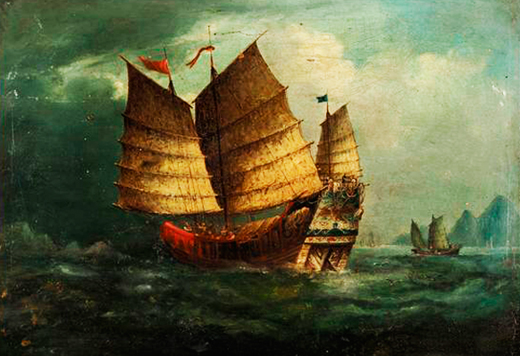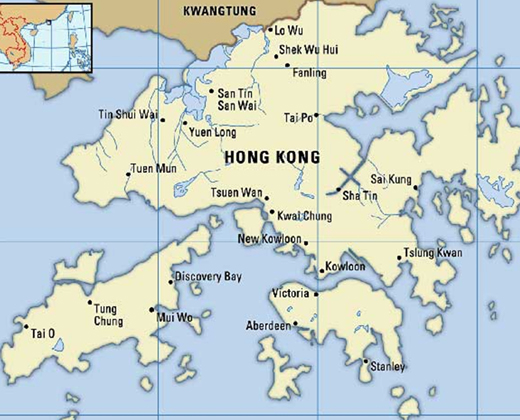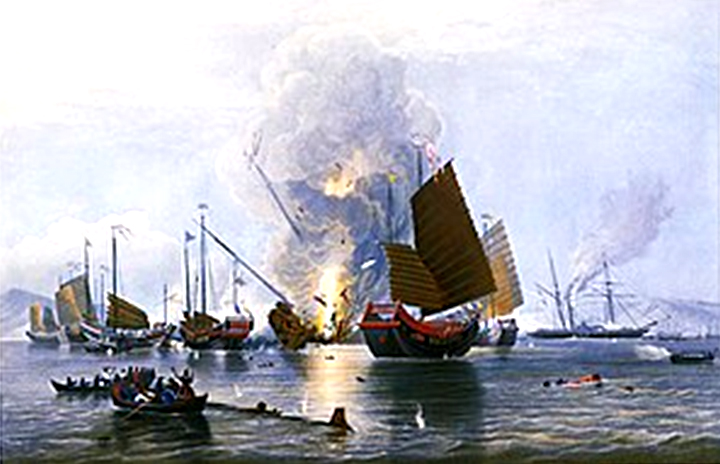Mangalore in Kowloon
Mangalore in Kowloon
Mangalore Today News Network
A ship named ‘Mangalore’ had played a crucial role in the Battle of Kowloon, which was fought between British and Chinese ships off Kowloon, China, on 4 September 1839 (often called "the first shot of the First Opium War”). Hence it would be most befitting that a warship of the Indian Navy be named ‘Mangalore’ in memory of that ship, argues the author.
By Dr G. ShreeKumar Menon
Mangaluru, Feb 24, 2018: A peep into the pages of history gives valuable insights about past conflicts that erupted between nations, their causes and how if they can be reignited can provide solutions to present disputes! A trenchant remark by George Orwell states “Who controls the past controls the future. Who controls the present controls the past.” India has been having a continuous problem with the Chinese on its borders. An expansionist China is aggressively inciting repeated incursions in the North East of India. The China–Pakistan axis is constantly engaged in keeping the international land border adjoining India in a state of deep turbulence. The constantly simmering borders keep us anxious and tense. But, just over a century back the story was different.


Kowloon encompasses the northern part of Hong Kong, on the mainland across Victoria Harbour. Once a separate city, it was acquired by Britain in 1860 and returned to China with the rest of the colony in 1997
The Battle of Kowloon was fought between British and Chinese ships off Kowloon, China, on 4 September 1839. It has been called "the first shot of the First Opium War”. Subsequent events, led to the First Opium War, a defeat which began an era known in China as the “century of humiliation.” It was only when Chairman Mao Zedong stood atop Beijing’s Gate of Heavenly Peace on October 1, 1949 and proclaimed the founding of the People’s Republic of China did this ‘century’—which actually lasted 109 years—come to an end.
“The British seizure of Hongkong was an aspect of one of the ugliest crimes of the British Empire: the takeover and destruction of India, and the use of India to flood China with opium” so opined Robert Trout. Indian flooding of China with Opium resulted in “Ten million Opium addicts in China, prompted the Governor Lin to recommend to the Emperor in Peking to promulgate rules to “rehabilitate those desirous of quitting Opium consumption habit, eighteen months time was given to surrender the Opium, foreigners engaged in the trade would be beheaded, and Chinese dealers would be strangled. Corrupt officials who looked the other way in return for bribes would also suffer the death penalty.”(Opium Wars: The Addiction of One Empire and the Corruption of Another by W. Travis Hanes and Frank Sanello)
Chinese traders were paying in silver for the prized Opium. Thus the traders were not only poisoning the Chinese citizens but also draining the Emperor’s Treasury. But the merchants could not be deterred; they had no intention of surrendering the goods and abandoning the lucrative business. They had a convincing excuse; the contraband did not belong to them, but to merchants far away in India. Ships from India were headed towards China bringing in huge quantities of Opium. One of the most prominent British traders of the time was Matthew Jardine. His company Jardine, Matheson & Co owned two ships, named, ‘Mangalore’ and ‘Carnatic’. Yes, the ship sported the great name ‘Mangalore’, which even now no warship or cargo ship is sporting. On July 7th 1839, these two ships landed in Kowloon loaded with Opium. The Boatswain of the ship ‘Mangalore’ was one Thomas Tidder. A group of sailors consumed a local rice liquor known as samshu, and thereafter in a drunken brawl killed a local named Lin Weixi in the village of TsimSha Tsui. This event culminated in The Battle of Kowloon (which was fought between British and Chinese ships off Kowloon, China, on 4 September 1839, and as mentioned earlier, has been called "the first shot of the First Opium War.”)

British opium from East India was pumped into China in huge amounts from the early 19th century. In the 1830s, concern about the drug’s effects on the population and economy led the Qing dynasty to ban it, and they ordered a senior official, Lin Zexu, to blockade British opium ships in Canton harbor until they agreed to hand over their cargo. In Britain, this was seen as an insult to the Crown, and a fleet under Admiral Charles Elliot was sent out to teach the Chinese a lesson. British military technology soon destroyed the Chinese defenses, and after three years of coastal fighting, the war ended with the Nanjing treaty of 1842 which handed over Hong Kong Island and opened up the interior to trade and Christian missionaries. For the next century, China was subjected to further invasions and humiliations, which ended only with the termination of special western rights in China in 1943 under Chiang Kai-shek.
Little is known about the fate of the ship ‘Mangalore’; it is all lost in the mists of Time. Except for a brief mention that many Indian sailors were injured, there are no records available. Anyway it is a matter of pride that in the Battle of Kowloon, a ship named ‘Mangalore’ had played a crucial role. It would be most befitting that a warship of the Indian Navy be named ‘Mangalore’ in memory of that ship which also played a role making the Chinese to live in humiliation for over a century. Let those who periodically rattle our borders not forget that we had once made them to tremble.
 About the author: Dr G ShreeKumar Menon, IRS (Rtd) Ph.D (Narcotics) is a Former Director General, National Academy of Customs Excise and Narcotics & Multi Disciplinary School of Economic Intelligence; Fellow, James Martin Center for Non Proliferation Studies, USA; Public Administration, Maxwell School of Public Administration, Syracuse University, USA and AOTS Scholar, Japan. He presently serves as Registrar, Yenepoya University, Mangalore – 575018. He may be reached at shreemenon48@gmail.com
About the author: Dr G ShreeKumar Menon, IRS (Rtd) Ph.D (Narcotics) is a Former Director General, National Academy of Customs Excise and Narcotics & Multi Disciplinary School of Economic Intelligence; Fellow, James Martin Center for Non Proliferation Studies, USA; Public Administration, Maxwell School of Public Administration, Syracuse University, USA and AOTS Scholar, Japan. He presently serves as Registrar, Yenepoya University, Mangalore – 575018. He may be reached at shreemenon48@gmail.com
- Spiking of drinks, a grave threat for students’ security
- Burden of drugs and substance use among university students in India
- Mangalore medic’s miracle in Bombay 1957
- Needed a national protocol for treatment of substance use disorders
- The Lingering Menace of Drug Abuse Among the Indian Youth—It’s Time for Action
- Need For ‘Students, Alcohol and Drugs’ survey
- New Synthetic Drugs Trapping Youth
- Mood Modifying Chips - Future of Drug Use
- Ramping up Indo-Bangla border security
- IITM- A premier educational Institution in a forest. What can we learn?
- Former PM, Manmohan Singh: Notable laws passed under his tenure
- Hashish on Ratnagiri Seashore
- The Poor cry out to Us: Do we respond?
- Kashmir Bhavan in Bengaluru: A must visit place
- "MAI and I" Book of Angelic Emotions
- Draupadi Murmu - The New ’President of India’
- Anthony Ashram in the city grows a classic museum
- First College of Fisheries in India - A Golden Jubilarian
- Flushing Meadows - A Vintage Mansion
- The Colonel�s Bequest
- A Mangalorean PM and his RBI Governor Brother: The Extraordinary story of the Benegal Brothers
- There is no higher religion than Truth: Theosophical Society
- L�affaire - Ashu & Yiju of Mangalore
- Mangalore in Kowloon
- 1568 to 2018 AD: 450 years of Christianity in Mangaluru
- Vice President elect Naidu moves on from nadir to zenith, the phenomenal journey
- Embracing the Outdoors: How Heated Jackets Are Revolutionizing Cold Weather Activities
- Efficient and Sustainable Packaging Solutions with FIBCs
- The Hybrid Kilt Revolution | Where Tradition Gets Trendy
- Affordable Elegance | Embrace Style on a Budget with Cheap Kilts
- Unleashing Style and Functionality | Exploring Tactical Kilts
- Mangalore’s Heroic Lady marks 105th Birthday
- Santa the Christmas spirit
- Geriatric care: Mangalore strikes a fine balance
- The Don Who Made Two Empires to Clash
- CHITRAPUR SARASWATS - A Great Kanara Community
- Our new President Ram Nath Kovind’s significant journey to Rashtrapathi Bhavan
- Marriages made in heaven, big fat weddings made in India
- Eid insight - The giver of glad tidings
| Comments on this Article | |
| I j s shet, M’lore | Tue, February-27-2018, 12:16 |
| Very valid and interesting account. Kudos to the authour.....Thanks. | |
- CITY INFORMATION
- TRAVEL
- TOURIST INFORMATION
- HEALTH CARE
- MISCELLANEOUS




 Write Comment
Write Comment E-Mail To a Friend
E-Mail To a Friend Facebook
Facebook Twitter
Twitter  Print
Print 

